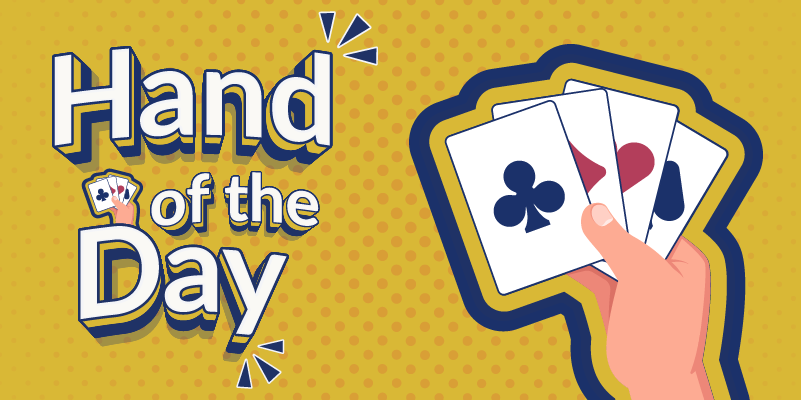Best Answer: 2♠
Your double shows 7+ points or 6 points with good distribution. It also shows at least 4 cards in Hearts. So, if partner also had 4 cards in Hearts, they would have supported with 2♥ . The 2♥ bid from partner isn't a reverse bid after your double, given your double is the same as if you bid 1♥ .
Both you and partner have opening points, so you need to show interest in game. Therefore bid 2♠; a cue bid, showing a game forcing hand. With this bid you don’t promise Spade values. On the contrary, you normally want to know if partner has a stopper in opponent's suit. With this bid you're asking partner to keep on describing their hand.
Your partner will then bid NT if they have a Spade stopper.
Bidding 3NT from your hand isn't good, as you don’t have a Spade stopper. And if partner doesn’t have a stopper either, it means opponents can take at least 5 Spade tricks on top.
Bidding 2NT would also promise stopper and shows only 11-12 points or 10 points with better hand.
3♣ would also show 10-11 but partner might pass.
Then, what does the 2♥ mean as a rebid after the Double?♥ after the 1♠ overcall, as shown here:
And with your original hand, the bidding could be:
In this case 2NT by partner shows a minimum opening and a Spade stopper. Therefore, you can then bid 3NT.
Reminder :♦ rebid needs an agreement. You can decide whether:
Best Answer: Pass
After this auction, with your hand, there's only one possible bid - Pass.
It's true that when partner changes suit you need to bid, but when opponent overbids, you can pass with minimum points, as the bidding will return to partner regardless.
This way your partner knows you've minimum opening points but you've nothing more to offer. They can then count their points plus your minimum opening hand and make a decision on whether to continue or not.
If you went with a 2♠ bid; a reverse bid, it would show strength with 17+ or 16, good distribution and an unbalanced hand.
A 2NT rebid would show 18-19 points with balanced hand.
Why doesn't 2NT show 12-14 points with a balanced hand?♦ , you don’t want to play 2NT with 13 points plus a possible minimum of 6 points with partner. Opponents could have more points than you do.
A 3♦ bid would be game forcing.
Double would be a support double, and would show 3 cards in Heart, which you don’t have.
Then, what about a possible Spade fit? Partner might have 4 cards in Spades too.
Don’t worry, you'll find the fit, as partner can bid again with lots of options:♥ , if they've length in Hearts and a weak hand.
The hand could be:
You can see the bidding go on, and how you can reach the right game. Your 2♠ bid after partner's double isn't a reverse bid, as you've passed before. You were still showing minimum points because you passed after opponents overcalled.
Partner could also choose a 2♠ bid after your pass with a game forcing hand. It would mean they have opening points (12+ points or 11 points with better distribution).
Reminder :
When partner changes suit at the 1 level it shows 6+ points. So if they have minimum points you won't make 2NT, not to mention game.
When partner responds with a change of suit, you must bid as their hand isn't limited unless opponent bid something after partner's response; then you may pass, as bidding can still return to partner so they can bid on (as in the example above).
When partner responds with a change of suit at the 1 level, a 2NT rebid by you is always going to show 18-19 points (unless you play an artificial 2NT), whether or not your opponent overcalls.
If playing the SAYC system, when partner responds with a change of suit at the 2 level, it's showing 10+ points. You can then rebid 2NT, showing 12-14 points or 3NT, showing 18-19 points.
If playing a 2/1 system, responding with a changed suit at the 2 level is already game forcing. Therefore a 2NT rebid could be minimum points either (unless you've another agreement).
Best Answer: ♠A and ♠J
Against 3NT, your partner leads the ♠5 and declarer plays the ♠2 on dummy. How will you play?
From the bidding, you can see that the declarer has 5 cards in Hearts, 4 cards in Diamonds, and at least ♣Kx.
How do we know that declarer has at least ♣Kx?
Now we know that Declarer has a maximum of 2 cards in Spades we can deduce that partner has at least 5 cards in Spades.
Partner leads with the ♠5. It's 4th best and promises an honor – in this case the ♠K, given you hold the ♠AJ and the ♠Q is in dummy.
As the ♠42 is in dummy it's now clear that partner has exactly 5 cards in Spades - ♠KXX53.
You also need to hope that partner has an entry to their hand in Hearts. Otherwise, if declarer has running tricks in Hearts, your opponents will easily make the contract; if partner doesn’t have a stopper in Hearts, there's no way to set the contract down.
If you win with the ♠J at trick 1, you'll block the suit. Winning with the ♠J, then playing the A, and then Hearts to partner's ♥ A is not enough. After winning, the declarer still has ♠QX in dummy to stop partner from running the Spades.
You've seen here that you and dummy have 21 points. As an opener declarer has at least 12 points. So partner has a maximum of 7 points, and you know that they have the ♠K, so it would appear that partner isn't likely to have more than 1 entry to their hand.
Therefore, you need to win the ♠A at trick 1 and continue with the ♠J at trick 2 to partner's ♠K. Partner can now continue with the ♠10 to knock out the ♠Q in dummy. Then later partner can win the ♥ A to enjoy the remaining 2 tricks in ♠ to go 1 down (4 Spades and 1 Heart trick for the defense).
Reminder :
a. North could bid 3NT directly, having a Club stopper, without 5 cards in Spades. However, 3♣ could be useful as slam in Diamonds is possible, especially if opener then bids 3♦ with something like ♠KX ♥ AKXXX ♦ Q10XXX ♣X.
Best Answer: ♣A, ♥ AKQ, and a Heart ruff in dummy.
Sitting south, with a contract of 5♦ ;
From West's overcall, it's clear that East can't have more than 2 cards in Clubs. Also, with doubleton East would follow high–low. Given East follows with the ♣7, and you've seen the ♣432 are in dummy, and the ♣65 are in your hand, the ♣7 can't be high–low as East has no lower card than the ♣7.
So, if you play low at trick 1, you risk getting ruffed on trick 2, plus you lose a Spade trick. It could cost you going down twice; club ruff, a spade to West, and another club ruff.
The only way to make is to hope that Hearts are 4-3 and play as follow:
Win ♣A, continue with ♥ AKQ (discarding a Club from dummy on the 3rd Heart), then ruff the 4th Heart with dummy's ♦9. After that, lose the 2nd Club to West. It'll give you the time to ruff. Then, play the 3rd Club and ruff in dummy with the ♦ Q. Doing this will mean you'll only lose 1 Club and 1 Spade.
If you pull out 2 Diamond rounds, you won't be able to ruff Club later, as you'll have no trumps remaining after the Heart ruff.
If you pull out 1 Trump round and try to play as mentioned above, then after losing the Club, West can play another trump and you'll have no trumps remaining for the Club ruff.
If you play ♥ AK and ruff the 3rd Heart, opponents can ruff your 4th Heart when they get the hand with the ♠A. If you pull trumps you won't be able to do the Club ruff.
If you play Spade at trick 2, then opponents can play trump, and after winning their Club trick they'll play the 2nd trump. Again, you won't manage 2 ruffs in dummy.
Reminder :♦ , 3 tricks in ♥ , 1 trick in ♣ = 9 tricks, or,♥ , 2 in ♣ = 4 losers.
We count losers from 1 hand, normally the long trump hand.
Here we have 9 tricks or 4 losers. Given you can afford only 2 losers, and as you can't discard any of the 4 losers on a high card from dummy, so your plan should be to ruff twice in dummy. Which is also why you play ♥ AKQ to discard a Club so that later you can ruff a Club in dummy.
2. When you play a trump contract, you have 2 ways to get rid of losers:
Your trump tricks are counted from the long hand. Therefore, each ruff from the short hand is an additional trick. Or it can be said that each ruff from the short hand is the same as 1 more trick in the trump or 1 fewer loser.
3. Apparently 3NT is a better contract here. After the 2♥ reverse, North could've bid 2♠. So, it would be easier for South to offer 3NT because North can see that as South didn’t Double 2♣, it follows that South has no Spade tolerance.
If you are human, leave this field blank.
Submit






Excellent quiz
In hand 3,West must have SKxx53(x is higher than 6),or dummy's S7 would stop this suit twice besides SQ.
Ręka 4: lepsze rozwiązanie A cl KhAh 4h/Qd ; 9d ; 2d/Ad & diam ... Kiery mogą się dzielić 5:2 . Podane przez Pana rozwiązanie wygrywa przy podziale kierów 4:3.
good analysis and clear enough thx
Nice one. I tripped on the last problem
Very good questions. Answers are also extensional.
New to bridge would love to do more of these
Thanks
Hand 1...Doesn't UCB also suggest 3+ support for partner's suit?
Enjoyed the challenge!
another excellent quiz
On the last hand, if you play spade at trick 2, West will immediately make 1 spade honor and 2 clubs.
really insightful!!!
At last, a 20/20! Good thing is that it took me less than a minute in total and all the answers seemed really obvious to me. I am either having a rare moment of clarity or (more likely) Oren has decided to make people feel good about their bridge skills. Worked on me anyhow! 😛
Thought-provoking hands. Thanks a lot.